Spraying Systems AutoJet ES250 User manual

AutoJet® ES250
Electrostatic Chain
Oiler System
ML00ES250F
spray.com
OWNER’S MANUAL

1. Preface ········································································································································ 3
1.1 Important ········································································································································ 3
1.2 How To Use This Manual················································································································ 3
2. Safety ·········································································································································· 3
2.1 General Safety Informaon············································································································ 3
2.2 Unpacking the System····················································································································· 4
3. ES250 Overview ··························································································································· 5
3.1 Electrostacs Spraying Overview··································································································· 5
3.2 System Components and Installaon Requirements····································································· 5
4. Electrostac Spray Control Panel·································································································· 6
4.1 Mounng the Panel and Door Diagram ························································································· 6
4.2 Connecng the High Voltage Cable································································································ 7
4.3 Circuit Board (PCB) and Terminal Block Diagram··········································································· 8
4.4 Input Details ································································································································· 11
4.5 Output Details ······························································································································ 13
4.6 Potenometers ···························································································································· 16
4.7 System Modes······························································································································ 16
4.8 Oponal PCB Inputs and Connecons ························································································· 18
4.9 Verifying the Spray Control Panel Set Up ···················································································· 19
5. Fluid Reservoir Assembly ··········································································································· 20
5.1 Mounng and Posioning············································································································ 20
5.2 Fluid Reservoir Connecons········································································································· 21
5.3 Lubricant Pump ···························································································································· 22
5.4 Components ································································································································· 23
5.5 Air Pressure Regulator·················································································································· 23
5.6 Parculate Filter··························································································································· 25
5.7 Verifying the Fluid Reservoir Assembly Set Up············································································ 25
6. Electrostac Chain Oiler Spray Nozzle························································································· 26
6.1 Nozzle Overview··························································································································· 26
6.2 Nozzle Connecons······················································································································ 27
6.3 Nozzle Disassembly Procedure ···································································································· 27
6.4 Nozzle Conguraon and Adjustment························································································· 28
7. Faults and Troubleshoong········································································································ 29
7.1 Faults and Fault Codes ················································································································· 29
7.2 Fault LED Status···························································································································· 30
7.3 General System Troubleshoong································································································· 32
7.4 Arc Fault Troubleshoong············································································································ 33
8. Spare and Replacement Parts····································································································· 34
TABLE OF CONTENTS

3
3
1.1 IMPORTANT
The AutoJet® ES250 Electrostac Chain Oiler System and its components are produced, tested, and checked at the
factory. The system can be dangerous if used incorrectly. Read this manual carefully and pay special aenon to any
safety instrucons.
Operators must always follow the general safety instrucons in the working area and aim to prevent accidents.
The manufacturer reserves the right to make changes in standard construcon without prior nocaon.
Images and diagrams in this manual may not be exact representaons of your system conguraon.
1.2 HOW TO USE THIS MANUAL
This manual is intended to be a source of informaon for the operators and technicians who may be installing, inter-
acng with or servicing/maintaining Spraying Systems Co.® systems and components.
This manual contains important safety warnings, installaon instrucons, operang instrucons, troubleshoong
and maintenance informaon.
ICONS
WARNING: The user can be seriously injured, damage their health, and/or damage the system.
CAUTION: Product, process, or environment can be damaged or be in danger if the instrucons are
not followed correctly.
ATTENTION: Supplementary informaon for the user that draws aenon to possible problems.
2.1 GENERAL SAFETY INFORMATION
READ AND FOLLOW INSTRUCTIONS
All safety-related and operang instrucons should be read before the system is operated. Follow all operang
instrucons.
SERVICING
Do not aempt to service this system unless you have been trained or authorized to conduct repairs. Only authorized
and qualied service personnel should aempt to service this system. Service by unauthorized personnel may void any
and all warranes.
WARNING: Before performing any maintenance, make sure electrical power is o and any air/liquid
pressure is bled from the system.
REPLACEMENT PARTS
This system has been designed with components that work together to provide the best system performance. When
replacement parts are required, only Spraying Systems Co.® recommended components should be used to maintain
proper system operaon, electrical and pneumac safety. The use of any unauthorized replacement parts will void any
warranes.
UNINTENDED USE
Use of Spraying Systems Co.® equipment in ways other than those described in the documentaon supplied with the
equipment may result in injury to persons or damage to property. Examples of unintended use of equipment:
SECTION 2
SAFETY
SECTION 1
PREFACE

4
• Using incompable materials or damaged parts
• Making unauthorized modicaons or using unapproved auxiliary equipment
• Removing or bypassing safety guards or interlocks
• Operang equipment in excess of maximum rangs
REGULATIONS AND APPROVALS
Make sure all equipment is rated and approved for the environment in which it is used. Any approvals obtained for
Spraying Systems Co. equipment will be voided if instrucons for installaon, operaon, and service are not followed.
All phases of equipment installaon must comply with federal, state, and local codes.
PERSONAL PROTECTIVE EQUIPMENT
Spraying Systems Co.® strongly recommends the use of appropriate safety equipment when working in potenally
hazardous environments and chemicals. This safety equipment includes, but is not limited to, the following:
• Protecve hat, chemical-resistant safety gloves, and apron
• Safety glasses/face shield, long sleeve shirt and long pants
Users of this product should never place themselves in the path of the spray. Users should consult and follow the
recommendaons of the Safety Data Sheet (SDS) of any chemical or uid sprayed using this system.
PRESSURIZED SYSTEMS
It is important to recognize proper safety precauons when using a pressurized spray system. When dealing with
pressure applicaons, the system pressure should never exceed the lowest rated component. Always know your
system, all component capabilies, maximum pressures and ow rates.
WARNING: Fluids under pressure can penetrate skin and cause severe injury.
ATTENTION: Always remember to carefully read the chemical manufacturer's labels, follow SDS and
all direcons.
WARNING OF SHOCK HAZARD
To reduce the risk of electric shock, do not open the cover on electrical control panel. For service contact
Spraying Systems Co.® at 1-866-321-2250.
WARNING: Plug panels into A GFCI outlet.
WARNING: To prevent injury, avoid contact with potenally hot parts. Components can cause severe
burns. Do not aim the spray at any person or part of the body. Do not place any part of your body
into the spray paern.
USE OF CHEMICAL COMPONENTS
Spraying Systems Co. does not manufacture or supply any of the chemical components used in this equipment and is
not responsible for their eects. Because of the large number of chemicals that could be used and their dierent
chemical reacons, the buyer and user of this equipment should determine compability of the materials used and any
of the potential hazards involved.
2.2 UNPACKING THE SYSTEM
The system components come carefully packaged to protect them from damage. Use cauon when opening the crate.
The crate will contain all parts needed to install the unit. Parts of the unit may be wrapped in bubble wrap. Remove all
of the packaging material wrapping the system. Once unpacked and removed the from the crate, the system is ready
for installaon and connecon.
CAUTION: The packaging may contain exposed cables, hoses, and other components. Always
exercise cauon when opening boxes to avoid accidental damage or slicing of various components.

5
5
3.1 ELECTROSTATICS SPRAYING OVERVIEW
In electrostac spraying, a negave charge is introduced into a uid in the nozzle body through a central charging elec-
trode, which causes the uid to acquire a negave charge. When this negave charge is applied to the uid, this causes
the uid molecules to repel each other, following the principle that molecules with opposite charges will aract and
molecules with like charges will repel. Electrostac spraying relies on the repulsion of these like-charged small uid
droplets.
Aer leaving the nozzle orice, the uid molecules connue to repel each other as they travel, causing the already
small droplets to break up into even smaller droplets. This process will connue unl the repulsive force between the
molecules is no longer strong enough to break the surface tension and split the droplet again.
These ny and uniformly sized droplets retain their negave charges and will be aracted to any neutral, grounded
target nearby with an aracve force stronger than gravity. Electrostac forces pull the liquid molecules towards this
target, thinly and evenly coang the target surface and providing a very high uid transfer eciency
Some benets of electrostac spraying include:
• Low ow rates that allow for less uid usage
• Reduced product and workspace contaminaon due to overspray
• Shorter workspace cleanup mes
• Longer intervals between system maintenance
• More uniform target coangs, typically achieving over 90% transfer eciency
3.2 SYSTEM COMPONENTS AND INSTALLATION REQUIREMENTS
This electrostac system includes the following main components:
• AutoJet® ES250 Electrostac Spray Control Panel
• Fluid Reservoir Assembly
• Electrostac Chain Oiler Spray Nozzle
CUSTOMER REQUIREMENTS FOR INSTALLATION
• Mounng locaons for all components that meet any and all naonal or local safety standards
• 40 psi (minimum) shop air connecon
• 24 VDC power supply to provide power to the control panel’s circuit board, the solenoid valve connecon, and the
high voltage power supply (HVPS) —2.5 amp minimum
REQUIRED TOOLS FOR INSTALLATION
• 15 mm open ended wrench and 27 mm open ended wrench.
• Sloed screwdriver 3/8” (9.5 mm) or larger for accessing the panel)
• #2 Phillips head screwdriver (for removing the high voltage terminal block enclosure cover)
• #2 Square bit screwdriver or 3/8” (9.5 mm) sloed screwdriver (for ghtening high voltage terminals)
• 1/8” (0.125 mm) sloed screwdriver (for terminals)
• Wire strippers
SECTION 3
ES250 OVERVIEW
Table of contents
Other Spraying Systems Industrial Equipment manuals





















